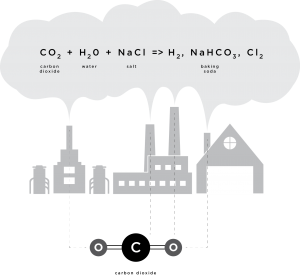Posts Tagged ‘Greenhouse Gases’
Another Chapter of “Why Don’t We See This in Midlothian?”
 Cement plants are among the world's largest sources of CO2. In order to reduce their carbon footprints, either voluntarily or to comply with new environmental regulations, as well as make a buck, owners are trying out different strategies to turn their Greenhouse Gases into just plain green cash.
Cement plants are among the world's largest sources of CO2. In order to reduce their carbon footprints, either voluntarily or to comply with new environmental regulations, as well as make a buck, owners are trying out different strategies to turn their Greenhouse Gases into just plain green cash.
As far as we can tell, the "SkyMine" pilot-project announced for San Antonio's Capital Aggregates Cement Plant is still on schedule for operation later this year. Employing 50 people, the first-of-its-kind facility will convert the cement plant's carbon dioxide into baking soda and hydrochloric acid that's aimed at oil and gas field use.
Now comes word that a LaFarge Cement Plant in Canada is hooking up with a fuel cell company to make a slightly more progressive product from its GHGs:
"Mantra Energy Alternatives has struck a deal with Lafarge Canada to deploy an electrochemical reduction technology at Lafarge’s No. 9 Road cement plant.
“This will be the first pilot plant of its kind in the world,” said Mantra’s vice-president Patrick Dodd in a press release.
On paper, the technology would convert carbon dioxide, considered the most prolific greenhouse gas, into useful chemicals like formic acid and formate salts. The pilot plant would convert 100 kilograms per day of carbon dioxide emitted from the local cement plant into concentrated formate salts, which sell for about $1,500 per tonne.
Mantra is eying the formic acid for use in its patented fuel cells, which it bills as a significantly less expensive fuel cell with greater power density."
Granted, the manufacturing of oil and gas chemicals sounds more likely for one of the three huge Midlothian cement plants to attempt than diving into the alternative energy business, but at least it's something. The end products can change and adapt but these projects begin to put the infrastructure of a supply and demand system in place while seeing potentially large decreases in CO2 output. In 2014 America, the fastest way to get reductions in GHGs is to make it profitable to do so. These experiments pave the way for that to happen.
There's no question that the TX/ Martin-Marietta, Holcim and Ash Grove cement plants are the largest stationary sources of CO2 in North Texas, or that together, they form a huge GHG hotspot. All the old coal-fired power plants that would have challenged them have been shuddered or converted to gas.
While (forced) modernization at all three plants like the conversion from wet to dry kiln technology has brought all emission totals down, particularly CO2, the fact remains that the huge scale of operations in Midlothian means there's no other facilities that churn it out as much. And yet not one creative idea for how to reduce those huge local emissions has been announced from any of those companies. You can't just use the Texas excuse because the San Antonio experiment is happening despite no immediate government mandate, especially on existing facilities. And you might think that the first company to do so would receive some needed good PR. But nope.
This has been another chapter of "Why Don't We See This in Midlothian?"
The Pipeline in the Room
 Let's just say upfront that it's a good thing the President will finally be taking action on climate change that doesn't require Congressional action. We won't linger on the fact that the changes he'll be implementing tonight round up (at least in computer modeling) to precisely the 17% cut below 2005 greenhouse gas pollution levels that he promised the world at the little-remembered Copenhagen climate summit in 2009. Apparently, Obama is concerned about his legacy concerning what the New York Times called "the defining environmental and economic challenge of the 21st century" and wants to be able to say he at least did what he said he would.
Let's just say upfront that it's a good thing the President will finally be taking action on climate change that doesn't require Congressional action. We won't linger on the fact that the changes he'll be implementing tonight round up (at least in computer modeling) to precisely the 17% cut below 2005 greenhouse gas pollution levels that he promised the world at the little-remembered Copenhagen climate summit in 2009. Apparently, Obama is concerned about his legacy concerning what the New York Times called "the defining environmental and economic challenge of the 21st century" and wants to be able to say he at least did what he said he would.
But how do you give a major address on climate change in 2013 without also at least mentioning the Keystone Pipeline, a project that more than one scientist believes could eventually lead to cancelling out all the reductions being promised in tonight's presidential address, and the pending decision for which has been the primary rallying point for climate change activists in America? From a political point of view, you really can't. But as has been pointed out before, Obama is among the least "political" of modern presidents. Funny how a guy who's done more to raise the profile of community organizing than anyone since Saul Alinsky seems to have never absorbed any of the basic principles of the profession.
Tonight's initiatives include a September deadline for greenhouse pollution limits for new power plants, a June 2014 deadline for regulating greenhouse emissions from existing power plants, a bevy of energy-efficiency measures for buildings and appliances and some token foreign aid to countries suffering the effects of climate change. But one can't help get the feeling that this is all just a prelude to approving the Keystone in three or four months. Let's hope that the President's desire for an worthwhile legacy on this issue gives him second-thoughts.
UPDATED, POST-SPEECH: Well, at least he did mention it. Here's the NYT's on the President's passing reference ot the Keystone Pipeline:
"He briefly addressed the pending decision on whether to allow the construction of a 1,200-mile pipeline from oil sands formations in Alberta to refineries in the Midwest and the Gulf Coast. Mr. Obama, who has been under heavy political pressure from opponents and supporters of the $7 billion project, said the pipeline should be built only if it did not have a major effect on the climate.
“Our national interest will be served only if this project does not significantly exacerbate the problem of climate change,” Mr. Obama said in a statement that cheered pipeline opponents. “The net effect on our climate will be absolutely critical to determining whether this project will be allowed to go forward.”
He did not lay out the criteria for measuring the project’s effect on the climate or say how big an impact he was willing to accept. Those decisions are still months away, White House officials said."
